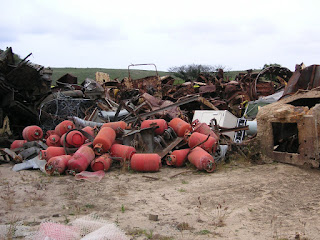 Fort Ord - Army Lands
Fort Ord - Army LandsMay 14, 2011
Thanks to the U.S. Army's Fort Ord Community Relations Office we joined a guided nature walk inside this non-public impact area (no pun intended). Eventually in 2020 this land will be turned over to the U.S. Department of the Interior's Bureau of Land Management (BLM) to expand the existing Public Lands to 15,000 acres. I've mentioned a couple times that the Fort Ord BLM Lands are my favorite local hiking spots (Creekside and Inter-Garrison), so it was exciting to get a glimpse of what will be.
I can't say I comprehend the process it takes to comply with all the laws and regulations, let alone the basic removal of potential explosives and lead contamination. There are so many entities involved and numerous websites; the best ones I've found are Fort Ord Reuse Authority (FORA) sites, old and new, and Former Fort Ord Environmental Cleanup. The Army's Munitions Clearance Program and Prescribed Burn Program are closely tied together, so I'll focus on the burn areas we toured.
I can't say I comprehend the process it takes to comply with all the laws and regulations, let alone the basic removal of potential explosives and lead contamination. There are so many entities involved and numerous websites; the best ones I've found are Fort Ord Reuse Authority (FORA) sites, old and new, and Former Fort Ord Environmental Cleanup. The Army's Munitions Clearance Program and Prescribed Burn Program are closely tied together, so I'll focus on the burn areas we toured.
 the bunker
the bunkerWe were given a couple route options, and we chose the hike that led up to the bunker where the surrounding areas were burned in 2003 and 2008. While it was a quick pace to keep ahead of the more leisurely group behind us that did not hike up to the bunker, I'm glad we did.
 2003 burn area
2003 burn areaI suspect this area on top of the sandy hill was a different habitat type than those shown below. Therefore, looking at vegetative growth post-fire doesn't compare for the 2003 burn. Most of the endangered and threatened plant species we saw were found here.
 2008 burn area
2008 burn areaShrubs, like silver bush lupine (Lupinus albifrons var. albifrons) and yellow bush lupine (Lupinus arboreus) have had enough time to grow back since 2008.
 October 2009 burn area
October 2009 burn areaThis was the first year I was at home to see the smoke plume from home. I took a picture and made note of it here on Nature ID for October 6, 2009.
 October 2010 burn area
October 2010 burn areaAgain, I took a picture of this particular 2010 burn from home and posted about it here on Nature ID for October 8, 2010. They also burned in September of 2010. I had expressed an interest to "tag along with the biology folks as they evaluate the September vs. October burn areas next spring." While I doubt a study like this is happening, I was so pleased to see fire poppies for the first time ever.
 planned 2011 burn area in the distance
planned 2011 burn area in the distanceYep, there'll be more fires through this decade until at least 2020. The first prescribed burn was conducted in 1997. Imagine over 20 years of regular fire, weather, and wildflower data?
vernal pool with soil excavation in 2008 burn area
The light green area in the center of both photos above is the same vernal pool from different vantage points. In the second photo, there's a wall to the right where soldiers trained to fire into the hill on the left. Due to accumulated munitions, the soil on the hill was excavated to sample and remove lead contamination.
As the cleanup process continues, various Army equipment used for target practice and heavier materials (and illegal dumping like the clothes dryer shown in the middle) get collected here in what is affectionately called the "iron triangle." A contractor will come in to recycle what can be recycled and haul off the rest... except for the Cold-War era tank 21 (last picture above), which will be kept as a historic display for the BLM. To read more about the history of Fort Ord, check out The California Military Museum's website.





2 comments:
As you can see I'm catching up on all your recent posts! It's nice that you can walk here at Fort Ord often.
My husband took his Army boot camp training there. He's from California, and had the choice between LA and Fort Ord. He's always had a love for the area and we had our honeymoon and first 6 anniversaries there in PG. We'd have retired there but didn't have the zillion dollars. :-)
I'm glad this area is being turned over to BLM,...hope they take good care of it.
Good choice! Hmm, you two must have been on an anniversary around the time they closed Fort Ord. It looks alot different now with dilapidated buildings, CSUMB, new housing, and shopping areas.
Did your husband get poison oak during training? I asked my uncle who trained here during the Korean War, and he grimaced from the memory of how bad it was.
Post a Comment